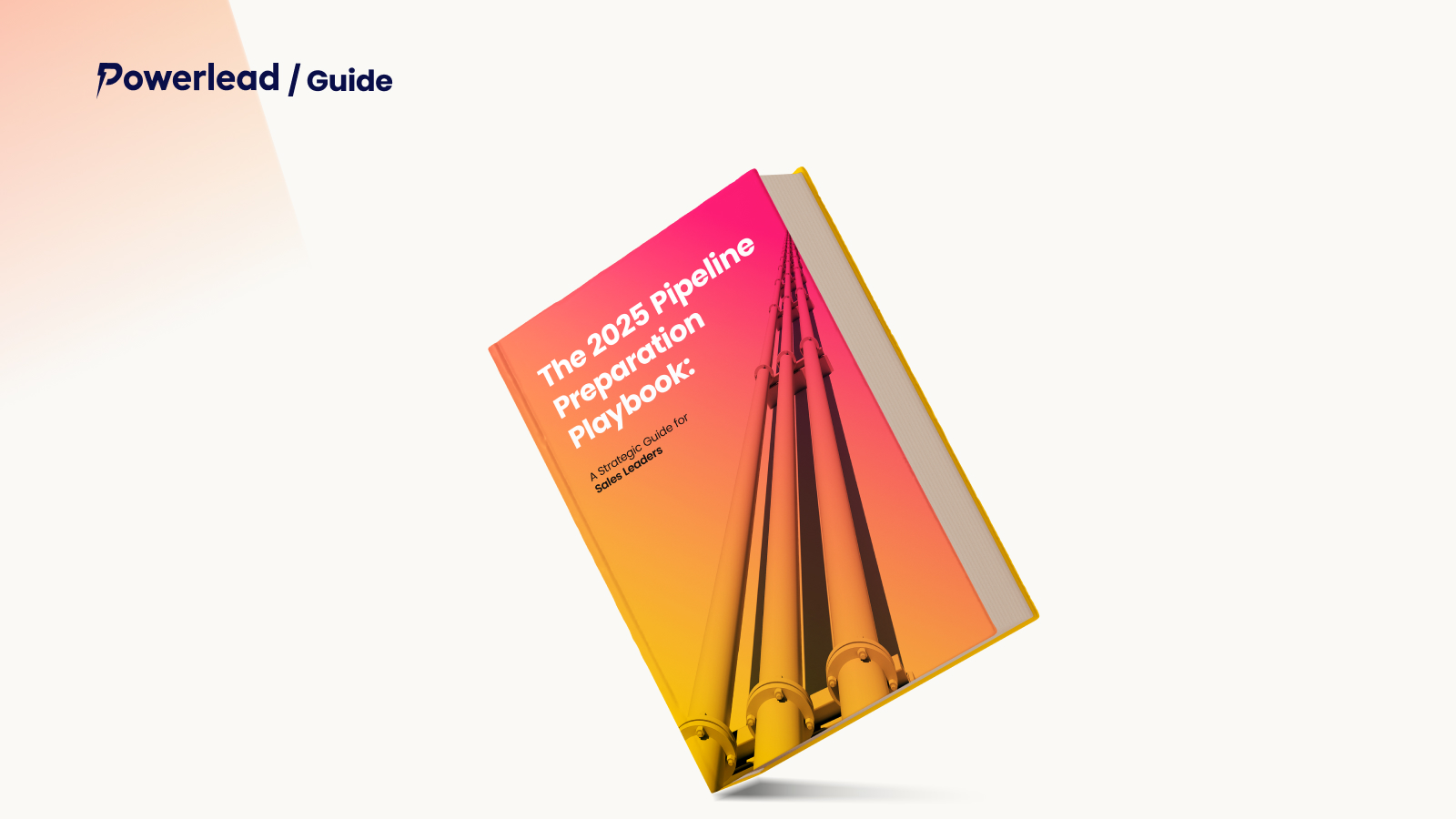Executive Summary
In this playbook, you’ll find:
- Actionable frameworks for immediate implementation
- Strategic timelines aligned with business planning cycles
- Best practices for technology and data integration
- Strategies for sustainable performance
- Clear metrics for measuring and optimizing success
This guide is for sales leaders who know that crushing their 2025 goals requires more than just tweaking last year’s approach. It’s for those ready to build something more robust, more predictable, and more aligned with where B2B sales is heading.
The time to prepare for 2025 is now.
PART I: STRATEGIC FOUNDATIONS
Strategic Timeline for Pipeline Preparation
Understanding when to begin your pipeline preparation for 2025 is just as crucial as knowing what actions to take. An effective pipeline strategy requires careful planning and systematic execution across multiple quarters. There is no point waiting for January SKO’s to get the ball rolling, the earlier you start, the earlier you’ll be ready to crush Q1.
The 90-Day Pipeline Preparation Framework
Q4 2024: Foundation Setting (October-December)
The final quarter of 2024 is critical for laying the groundwork for a successful 2025. This is the time to conduct a thorough assessment of your current pipeline health and begin preliminary preparation. Most organizations make the mistake of waiting until January to begin their preparation, putting them weeks or months behind their competitors.
Your key priorities during this period should be:
Conducting a comprehensive pipeline health check
Cleaning and validating existing pipeline data
Evaluating current conversion rates and identifying bottlenecks
Setting Preliminary Targets and KPIs for 2025
Beginning early-stage prospecting for Q1 opportunities
Early Q1 2025: Acceleration Phase (January-February)
While other organizations are just beginning their planning, your foundation work from Q4 should allow you to hit the ground running. This period is about activating your strategy and beginning aggressive pipeline-building activities.
Focus areas include:
Launching new prospecting campaigns
Implementing refined targeting strategies
Testing and optimizing messaging approaches
Establishing baseline metrics for the year
Industry-Specific Timing Considerations
Different industries have unique buying cycles and budget allocation patterns that should influence your timeline:
Technology and SaaS Budget refresh typically occurs in January, making Q4 outreach crucial for capturing early-year opportunities. Begin building relationships in October-November to position yourself for Q1 decisions.
Manufacturing and Industrial These sectors often operate on fiscal years ending in March or April. Adjust your outreach timing to align with their planning cycles, typically beginning serious conversations 3-4 months before their fiscal year end.
Healthcare and Education These industries often work with fixed budget cycles and longer procurement processes. Early engagement is crucial, with initial outreach happening 6-8 months before expected close dates.
Building a Robust Pipeline: Strategic Framework
A robust pipeline for 2025 requires more than just a list of potential deals. It demands a strategic framework that aligns your team’s efforts with modern buying behaviors and market dynamics. Here’s how to build it.
The Three-Dimensional Pipeline Framework
1. Strategic Account Selection
Gone are the days of casting a wide net and hoping for the best. Modern pipeline building requires a precise, data-driven approach to account selection. This means going beyond basic data to understand your total addressable market (TAM) in depth.
Start by analyzing your existing customer base to identify:
Common success patterns among your best customers
Industry-specific pain points and triggers
Decision-making structures and buying committee compositions
Revenue potential and growth trajectories
2. Engagement Strategy Design
With your target accounts identified, the next dimension focuses on how you’ll engage them. The key is creating a balance between personalization and scalability. Your engagement strategy should be:
Multi-Channel Build a presence where your prospects actually spend their time. This means coordinating across:
Direct outreach (email, phone, social)
Content distribution channels
Industry-specific platforms
Professional networks and communities
Value-Focused Each touch point should deliver clear value:
Industry-specific insights and trends
Relevant case studies and success stories
Actionable recommendations
Thought leadership content
3. Pipeline Velocity Optimization
The final dimension focuses on maintaining momentum throughout the pipeline. This requires:
Clear Stage Definitions
Each stage should have specific entry and exit criteria
Qualification frameworks must align with buyer journey stages
Progress indicators should be observable and measurable
Active Pipeline Management
Regular pipeline review cadence
Clear ownership of opportunities
Defined process for handling stalled deals
Systematic approach to pipeline cleanup
PART II: OPERATIONAL EXCELLENCE PILLARS
Data Architecture: The Foundation of Pipeline Excellence
The quality of your contact and account data isn’t just another operational concern—it’s the cornerstone of pipeline success. In an environment where buyers expect personalized, timely engagement across multiple channels, your data infrastructure determines whether you can meet these expectations or fall behind.
Think of your pipeline data as the fuel that powers your entire revenue engine. Just as a high-performance engine requires clean, high-grade fuel to operate at its peak, your pipeline operations need clean, accurate, and comprehensive data to drive results. This is especially true as organizations increasingly rely on AI and automation tools, which can only be as effective as the data they’re working with.
The True Cost of Poor Data
Bad data isn’t just an inconvenience—it’s a revenue killer. What appears as a minor inconvenience—a bounced email here, an outdated phone number there—actually creates a cascade of costly consequences across your entire sales operation.
Sales teams waste up to 40% of their time dealing with inaccurate or incomplete contact data. This isn’t just lost productivity; it’s lost opportunity. When your sales team spends nearly half their time managing data issues instead of engaging prospects, your entire pipeline suffers.
The ripple effects of poor data quality include:
Missed opportunities as decision-makers change roles unnoticed
Decreased team morale from repeated failed connection attempts
Lost credibility when outreach contains outdated information
Skewed forecasting due to unreliable pipeline data
Wasted marketing spend targeting invalid contacts
Building Your Data Foundation
Creating a robust data infrastructure requires a systematic approach that addresses both the strategic and tactical elements of data management. Here’s how to build it:
1. Data Quality Framework
Start by establishing clear standards for what constitutes quality data in your organization. Your framework should embrace three core principles:
Accuracy and Currency
The foundation of data quality begins with accuracy. This means:
Implementing regular contact information verification processes
Tracking and updating job changes proactively
Monitoring company changes (mergers, acquisitions, relocations)
Validating email addresses and phone numbers systematically
Completeness and Enrichment
Quality data goes beyond basic contact information:
Capture comprehensive contact details (direct dials, mobile numbers)
Include relevant background information (job history, responsibilities)
Track social media presence and engagement
Document interaction history and engagement patterns
Build understanding of organizational context
Accessibility and Actionability
Make your data work for your team:
Organize contacts by decision-making authority
Map relationships between contacts within accounts
Tag contacts based on buying committee roles
Link contacts to relevant opportunities
Enable easy data retrieval and updating
2. Maintenance and Governance
Establish clear processes and ownership to maintain data quality:
Define data entry standards and validation rules
Set update frequency requirements
Implement quality scoring criteria
Create automated verification workflows
Establish clear ownership for data quality
Regular auditing and cleansing protocols
3. Continuous Enrichment Strategy
Develop a systematic approach to enriching your data over time:
Identify critical data points for enrichment
Set priorities for data enhancement
Establish enrichment frequency
Define verification processes for enriched data
Monitor enrichment impact on pipeline performance
Remember: Data quality is not a one-time project but an ongoing commitment. Build your processes with sustainability in mind, focusing on automation where possible while maintaining human oversight for critical decisions.
Supporting Pillars
While data quality forms the foundation, two critical supporting pillars ensure your data infrastructure delivers maximum value: your technology stack and your team’s capabilities. Each plays a vital role in transforming good data into great results.
Technology Stack: Amplifying Data Value
In today’s sales environment, even the highest quality data can’t deliver optimal results without the right technology to leverage it. Your tech stack isn’t just about storing and managing data—it’s about making that data work harder and smarter for your team. The right technology transforms raw data into actionable intelligence, automating routine tasks and surfacing insights that drive better decisions.
To maximize your data strategy, focus on these key technology components:
CRM Integration and Management
Implement bi-directional data sync capabilities
Ensure real-time updates across platforms
Enable automated data validation rules
Create seamless workflow between systems
Automation and Enrichment
Deploy tools for automated data cleansing
Implement contact and company data enrichment
Set up automated verification workflows
Enable intelligent updating of changed information
Analytics and Monitoring
Establish data quality scoring systems
Track usage patterns and adoption rates
Monitor data accuracy metrics
Identify areas for improvement and optimization
Team Enablement: Turning Data into Action
The most sophisticated data infrastructure and technology stack are only as effective as the team using them. Your people are the critical link between data quality and business results. Creating a data-driven culture requires more than just training—it demands a systematic approach to enabling and motivating your team to maintain and leverage your data assets.
Build team capability through these focused initiatives:
Comprehensive Training Programs
Develop role-specific data handling guidelines
Create clear documentation and quick reference guides
Provide hands-on training sessions
Offer ongoing refresher training
Clear Processes and Protocols
Establish standardized data entry procedures
Define clear roles and responsibilities
Create escalation paths for data issues
Document best practices and common scenarios
Accountability Framework
Set individual and team data quality goals
Track and measure data management performance
Regular reviews of data handling practices
Clear consequences for non-compliance
Motivation and Recognition
Implement data quality incentives
Recognize and reward best practices
Share success stories and wins
Create healthy competition around data quality
Remember that these pillars must work in harmony with your data foundation. Regular assessment and adjustment of both your technology stack and team enablement programs ensure they continue to support your evolving data needs.
PART III: EXECUTION & OPTIMIZATION
Turning strategy into results requires a systematic approach to execution and a commitment to continuous optimization. This section provides a practical framework for implementing your pipeline strategy and measuring its effectiveness.
Performance Metrics: Defining Success
Having the right metrics in place isn’t just about tracking performance—it’s about predicting success and identifying potential issues before they impact revenue. While many organizations track dozens of metrics, focusing on a core set of meaningful indicators provides clearer insights and enables better decision-making.
Here are the essential metrics that will matter most for your 2025 pipeline:
Metrics #1: Pipeline Coverage Ratio
This fundamental metric measures the ratio between your current pipeline value and your revenue target. For predictable revenue generation in 2025’s longer sales cycles, maintain a coverage ratio of 3-4x your quota. This means if your quarterly revenue target is $1 million, you should have $3-4 million in pipeline value. This higher ratio accounts for increased deal scrutiny and longer decision-making processes.
Metric #2: Data Accuracy Rate
A crucial but often overlooked metric, your data accuracy rate measures the percentage of contact and account information that is current and actionable. This includes correct contact details, job titles, and company information. High-performing organizations maintain a minimum 85% accuracy rate, understanding that every percentage point below this threshold directly impacts sales productivity and conversion rates.
Metric #3: Multi-Threading Score
This metric tracks the average number of meaningful relationships you have within each target account. Given the complexity of B2B buying committees in 2025, successful deals typically require engagement with 6-10 stakeholders. Your multithreading score should track both the quantity of relationships and their quality—meaning their level of engagement and influence in the buying process.
Metric #4: Opportunity Velocity
More than just tracking how long deals take to close, opportunity velocity measures how effectively deals move through each pipeline stage. Calculate this by measuring the average time deals spend in each stage and identifying where they commonly stall. In 2025’s market, understanding and optimizing these transition points becomes crucial for maintaining pipeline momentum.
Metric #5: Engagement Quality Index
Move beyond simple activity metrics to measure the quality of prospect engagement. This composite metric considers factors like:
Response rates to outreach
Meeting show-up rates
Follow-up request rates
Content engagement levels
Buying intent signals
A strong Engagement Quality Index indicates not just activity, but meaningful progress toward sales outcomes.
Understanding these core metrics provides the foundation for the implementation and optimization strategies we’ll discuss next. Remember, the goal isn’t to track everything possible, but to focus on metrics that drive actionable insights and directly impact pipeline health.
Implementation Blueprint
Transforming your pipeline strategy from concept to reality requires a structured yet flexible approach. Success in 2025 demands methodical implementation that prioritizes data foundation while maintaining momentum. Here’s how to bring your strategy to life across three key phases:
Phase 1: Foundation (First 30 Days)
During this crucial first month, focus exclusively on getting your data infrastructure right. Begin with a comprehensive data audit to understand your current state – examining the quantity, quality and completeness of your contact data.
Establish your baseline metrics and identify critical gaps in your contact data. Common areas requiring immediate attention typically include outdated contact information, missing decision-maker details, and incomplete account hierarchies.
Phase 2: Optimization (Days 31-60)
focus on activating your strategy and beginning to generate results. Start implementing your new prospecting approach and launching targeted outreach campaigns. The key is to start small, measure carefully, and expand based on what works.
Begin by selecting a subset of your cleaned and verified contacts for initial outreach. Use this controlled group to test your messaging, timing, and channel strategy. Pay particular attention to response rates and engagement quality – these early indicators will help you refine your approach before scaling.
This is also the time to implement your new tracking systems and begin monitoring the metrics we outlined earlier. Set up regular checkpoints to assess progress and make necessary adjustments to your approach.
Phase 3: Scale (Days 61-90)
The final phase is about expanding successful practices while maintaining quality and consistency. By now, you should have clear indicators of what’s working and what isn’t. Use these insights to scale your winning strategies across your entire pipeline.
During this phase, focus on:
Expanding successful outreach patterns to your broader contact database
Implementing advanced tracking systems for pipeline velocity
Beginning predictive analysis to identify potential issues before they impact results
Establishing systematic processes for ongoing data maintenance and enrichment
The key to successful scaling is maintaining the same level of data quality and process discipline that you established in earlier phases. Create clear documentation of working processes and ensure your team has the training and resources needed to execute consistently.





